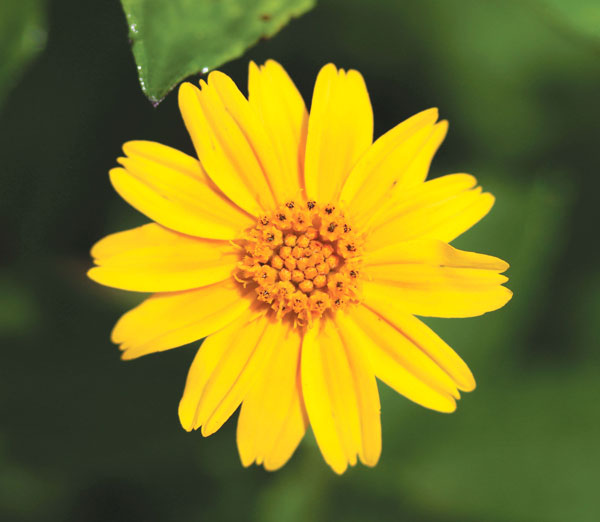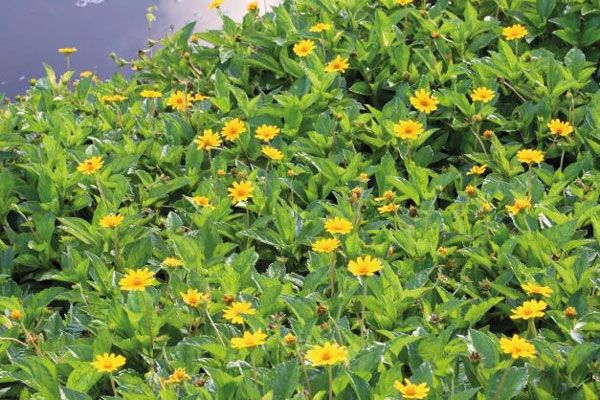
Battling Weeds: Singapore Daisy Control
Posted by Dale Parsons on 17th Jul 2023
Gardening in Australia's diverse climate can be both a delight and a challenge. One of the more formidable challenges involves dealing with stubborn and invasive weeds, such as the Singapore Daisy (Sphagneticola trilobata). A pretty flower to the uninformed eye, but beneath its deceptive charm, this insidious weed, originally from Central and South America, wreaks havoc on our precious native flora. Hence, the importance of managing such weed pests cannot be understated.
Controlling and managing weed pests like the Singapore Daisy is a multi-pronged effort. It involves understanding the pest's biology, judicious implementation of preventive measures, and, when necessary, the use of potent, targeted herbicides.
That's where Nufarm Associate Herbicide comes into the picture. Its active ingredient, Metsulfuron-Methyl, is uniquely equipped to handle stubborn broadleaf weeds and certain woody plants, including the Singapore Daisy. In the following sections, we will delve deeper into the nature of the Singapore Daisy, why it's a problem, and how tools like the Nufarm Associate Herbicide can play a significant role in its control and management. Let's start the journey towards a Singapore Daisy-free garden together.
The Singapore Daisy: An Invasive Pest

Singapore Daisy Closeup: Image sourced thanks to: www.daf.qld.gov.au
Despite its innocuous name, the Singapore Daisy (Sphagneticola trilobata) is an invasive pest that's increasingly causing concern for Australian ecosystems. This ground-covering weed, characterised by its bright yellow flowers and glossy green, sometimes variegated, leaves, appears delightful and even decorative. However, its beauty conceals a destructive nature.
Native to Central and South America, the Singapore Daisy is a perennial plant, thriving in both sun and shade. Its ability to withstand various conditions, including drought and poor soils, aids in its proliferation, making it a resilient adversary.
The Singapore Daisy is considered a weed pest in Australia due to its aggressive growth habit. It forms dense mats that smother all other ground flora, quickly overtaking local vegetation. Its prolific growth displaces native species, reduces biodiversity, and alters habitats, making it detrimental to the health of our ecosystems. Its impact is particularly significant in areas like Queensland's coastal regions, where it disrupts the natural balance of unique local biota.
The Singapore Daisy's aggressive spread can change the physical structure of an environment. Its dense growth prevents native seedlings from getting the light they need to grow, and it can even alter fire regimes in certain ecosystems. Moreover, the thick mat it forms can impede the movement of smaller animal species, further destabilising biodiversity.
Identification and Life Cycle of the Singapore Daisy
Identifying Singapore Daisy correctly is a crucial step towards its successful management. The plant has striking yellow, daisy-like flowers that bloom most of the year, giving it its common name. It has distinctive, dark green, glossy leaves that are usually lobed and have toothed edges.
Understanding the life cycle of the Singapore Daisy is equally essential. It's a perennial plant that can grow from seeds or vegetative fragments. These fragments, detached from the main plant, can develop roots and grow into new plants. This reproductive strategy and its ability to thrive in a wide range of conditions facilitates the weed's rapid spread.
The plant's ability to propagate from fragments also means that careless disposal of garden waste can inadvertently help the spread of the weed. Therefore, accurate identification and understanding the Singapore Daisy's reproductive strategies are vital in preventing its establishment and controlling its spread. With this knowledge, we are well-equipped to take the following steps in sustainable and effective weed management.
Controlling Singapore Daisy: An Integrated Approach

Singapore Daisy Infestation: Image sourced thanks to: www.daf.qld.gov.au
Given its invasiveness and resilience, controlling the Singapore Daisy requires an integrated pest management (IPM) approach. IPM is a holistic strategy that uses a combination of techniques to manage weeds effectively while minimising environmental harm. The IPM approach for the Singapore Daisy encompasses cultural methods, biological controls, and, when necessary, chemical controls.
Cultural Methods
Prevention is the first line of defence in weed management. Regularly checking your garden for signs of the Singapore Daisy and swiftly removing any sightings can help prevent its establishment. The plant's propensity to spread through fragments means that garden waste should be disposed of carefully to avoid unintentionally promoting its proliferation. Manual removal, while labour-intensive, can be effective if you ensure all fragments are removed and properly discarded.
Biological Control
Biological control involves using natural enemies to control weed populations. For the Singapore Daisy, studies are ongoing to identify potential biological control agents. While this control method offers promise, it is still under development and must be considered in the context of potential impacts on native species and ecosystems.
Chemical Control
When the Singapore Daisy has already extensively colonised an area, chemical control may become necessary. Herbicides should be used judiciously, targeting the weed while aiming to minimise any potential impact on non-target species. The herbicide chosen should be specifically designed to control broadleaf weeds like the Singapore Daisy.
While using chemical controls, always follow label instructions regarding dosage, application conditions, and safety precautions to ensure their effective and safe use. Also, monitor the treated area for regrowth; repeat treatments may be necessary to eradicate persistent weeds like the Singapore Daisy completely.
Through the IPM approach, we can take a comprehensive, environmentally responsible stance towards managing the Singapore Daisy. Let's delve deeper into how herbicides like Nufarm Associate, with the active ingredient Metsulfuron-Methyl, can aid in this endeavour.
Metsulfuron-Methyl / Nufarm Associate Herbicide
Your Ally Against Singapore Daisy

Singapore Daisy: Image sourced thanks to: www.daf.qld.gov.au
Nufarm Associate Herbicide (or Macspred Metmac), with its potent active ingredient, Metsulfuron-Methyl, is a significant ally in the fight against stubborn weed pests like the Singapore Daisy. This herbicide is a selective, systemic product, which means it targets specific plants while leaving others unharmed, and it works by being absorbed into the plant's system, disrupting its growth.
Metsulfuron-Methyl, the active ingredient in Nufarm Associate Herbicide, is a sulfonylurea compound. It inhibits the plant's production of essential amino acids, thereby disrupting protein synthesis and leading to the plant's death. This compound is especially effective against broadleaf weeds and some woody plants.
One of the main advantages of Metsulfuron-Methyl is its selectivity. It specifically targets specific types of plants, meaning it can be used to control the Singapore Daisy without causing widespread damage to other desirable plants in your garden. It's also highly potent, requiring only small amounts to be effective, making it a cost-effective solution for large infestations.
Using Nufarm Associate Herbicide correctly is crucial for its effectiveness and safety. Always follow the manufacturer's instructions. The herbicide should be applied, with a wetting agent like Wetter 600 for maximum penetration and 'stick', when the Singapore Daisy is actively growing for maximum absorption. Rainfast within two hours, it continues working even after a light shower. Avoid application during extreme weather conditions like high winds or rain, as this can result in the herbicide being spread to non-target areas or being washed away before it has a chance to work. Safety measures, such as wearing protective clothing and avoiding application near water bodies, should be followed to minimise potential environmental or health impacts.
The effectiveness of Nufarm Associate Herbicide in controlling the Singapore Daisy is significant, with results typically visible within 10-14 days of application. Remember that the plant's ability to propagate from fragments means that follow-up monitoring and possible re-treatment are necessary for complete control.
By understanding the power of Nufarm Associate Herbicide and using it responsibly, we can make a significant dent in the fight against invasive pests like the Singapore Daisy.
Sustainable Singapore Daisy Management

Singapore Daisy Flowers & Leaves: Image sourced thanks to: www.daf.qld.gov.au
Sustainable management of weeds like the Singapore Daisy is not just about eradicating invasive species; it's also about preserving and protecting our natural environment for future generations. This perspective calls for strategies that are effective in weed control and mindful of their environmental impact.
Sustainable weed management combines the best of all methods for a comprehensive, environmentally-friendly approach. Cultural methods such as diligent garden monitoring and immediate removal of any Singapore Daisy sightings should be every gardener's first line of defence. When the situation escalates, deploying biological controls can serve as a natural and eco-friendly solution. Chemical control, in the form of targeted herbicides like Nufarm Associate Herbicide, can be used responsibly to manage large infestations, ensuring they're used only when necessary and always per manufacturer's guidelines.
However, managing the Singapore Daisy does not end with treatment, be it manual, biological, or chemical. Regular monitoring and follow-up actions play a crucial role in long-term weed management. Following treatment, monitor the treated area for any signs of regrowth. Remember, the Singapore Daisy can propagate from fragments, so even a small piece left behind can potentially regenerate into a new plant.
Continued vigilance is essential for preventing re-infestation and ensuring that treatment, particularly if it involves herbicides, has been effective. Any signs of regrowth should be promptly addressed and re-treatment carried out if required.
By integrating these methods, we can promote a sustainable approach to managing the Singapore Daisy—one that considers not just the here and now but also our future. We can help protect our beautiful, diverse Australian landscapes from invasive weed pests through informed and responsible practices.
The Singapore Daisy, while beautiful to the uniformed eye, is a persistent invasive weed that threatens Australia's unique ecosystems. It's an adversary that demands our understanding and action. This aggressive weed's propensity to spread rapidly and smother native flora underscores the importance of a comprehensive and integrated approach to weed management, from prevention and identification to sustainable control strategies.
With its potent active ingredient, Metsulfuron-Methyl, Nufarm Associate Herbicide is a crucial tool in this fight. However, its use should always be responsible, paired with cultural and biological methods wherever possible, for a truly sustainable approach.
Let's remember that effective weed management is not just about eliminating the pest; it's protecting and preserving our rich biodiversity. Through informed action, persistent monitoring, and a commitment to sustainability, we can ensure a healthy and diverse environment for future generations.
Further Reading: Qld Government Department of Agriculture & Fisheries Guide on Singapore Diasy
